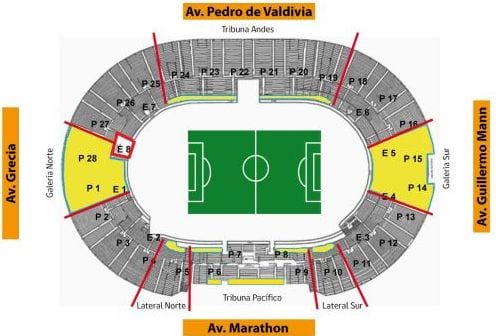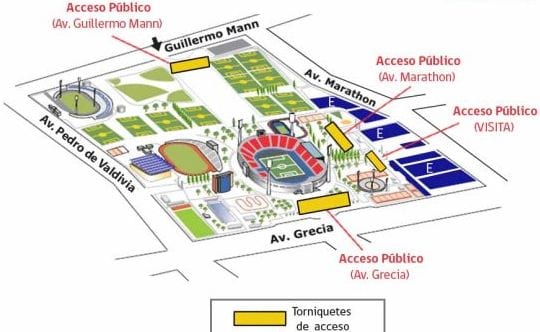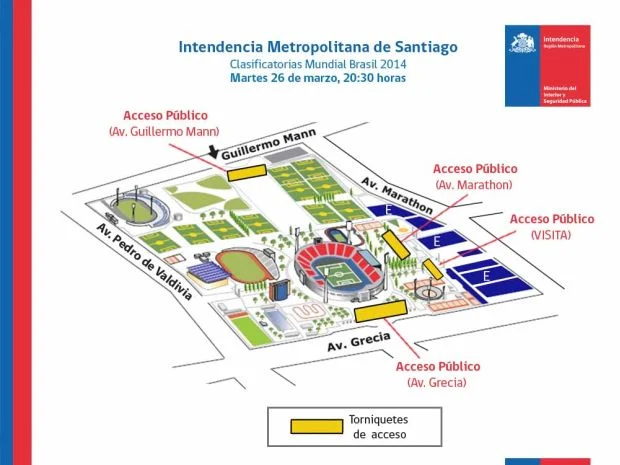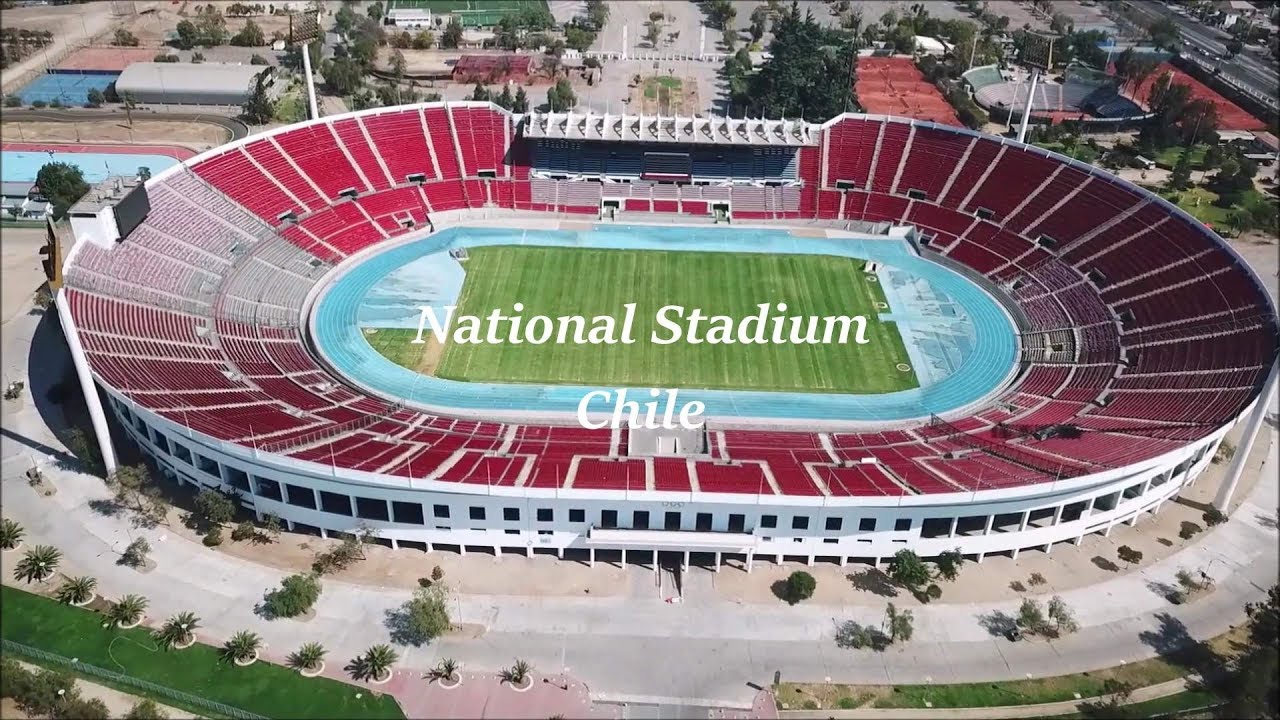The Estadio Nacional Julio Martínez Prádanos, commonly known as Estadio Nacional, is more than just a football stadium in Santiago, Chile. It stands as a symbol of Chile’s history, reflecting both its sports achievements and darker chapters from the country’s political past. This multi-functional venue has hosted significant events, from international sports to political gatherings, while also serving as a somber reminder of the military dictatorship. Whether you’re a football enthusiast, a history buff, or simply curious about Chilean culture, a visit to Estadio Nacional is a must.
1. Estadio Nacional and Its Ties to the Chilean Dictatorship
Estadio Nacional’s connection to Chile’s military dictatorship under Augusto Pinochet is one of the most harrowing aspects of its history. Following the coup on September 11, 1973, the stadium was transformed into an improvised detention center, where more than 40,000 political prisoners were held over the course of two months. The venue’s infrastructure, originally built for sports and entertainment, became a setting for interrogation, torture, and human rights abuses.
Loudspeakers, designed for announcing football plays, were used to call prisoners for interrogation. The velodrome, a space for cycling competitions, became a site for some of the most violent atrocities. Despite being a place of suffering during this period, Estadio Nacional has maintained this history with a memorial space, where visitors can learn about the dark past. A prominent inscription reads, “Un pueblo sin memoria es un pueblo sin futuro” (A people without memory is a people without a future), emphasizing the importance of remembering this tragic chapter.
This historical aspect of the stadium makes it a critical destination for those interested in Chile’s political past and the global fight for human rights.
2. Overview of Estadio Nacional
The Estadio Nacional Julio Martínez Prádanos was constructed between 1937 and 1938, officially opening its doors on December 3, 1938. The stadium was originally designed with a velodrome, but it underwent significant renovations to host the 1962 FIFA World Cup, one of the most notable events in Chilean sports history. The cycling track was removed, and the stadium was upgraded to meet international standards.
Estadio Nacional remains the largest stadium in Chile, with a seating capacity of 55,100. It is home to the Universidad de Chile football club and the Chilean national football team. The venue has hosted numerous iconic matches and has witnessed the highs and lows of Chilean football over the decades.

3. Capacity and Structure of Estadio Nacional
Estadio Nacional’s current capacity allows for 55,100 spectators, making it a central hub for large-scale sports events in Santiago. The stadium is designed to host football matches, concerts, and international events, such as Pope John Paul II’s visit in 1987. While it is mainly associated with football, Estadio Nacional has proven to be a versatile venue, accommodating events across various disciplines and sectors.
The stadium offers a sweeping view of the Andes Mountains, creating a visually stunning backdrop for both visitors and athletes. While much of the stadium is accessible to visitors, the field itself is off-limits to protect the playing surface.
4. Events Held at Estadio Nacional
In addition to hosting football matches for Universidad de Chile and the Chilean national team, Estadio Nacional has welcomed numerous international artists and global figures. Some of the world’s most famous performers have played at this venue, including Paul McCartney, The Rolling Stones, and Madonna.
For a full list of upcoming events at Estadio Nacional, visitors can check online for tickets and event schedules. Given its rich history and significance, attending a match or concert at Estadio Nacional is more than just entertainment—it’s a cultural experience.
5. Visiting Estadio Nacional: What to Expect
Visitors to Estadio Nacional can explore the grounds for free, walking through the stands and experiencing the grandeur of Chile’s largest stadium. While entry to the field is prohibited, guests are allowed to sit in the players’ benches and take in the magnificent view of the Andes Mountains from the stands.
It is important to note that tours and self-guided visits are not available during match days or team training sessions. However, on most days, the stadium is open for tourists who wish to see the venue and learn more about its history.
Beto Goés, a visitor who shared his experience on the blog LikeChile, recounted his tour: “When I arrived, there were no signs directing visitors to the correct entrance. After passing several gates, I finally found an employee who told me that access is through Gate 7. Once inside, the sheer size of the stadium was impressive. I sat on the players’ benches, though the locker rooms were closed to the public. The view of the Andes Mountains from inside the stadium was breathtaking.”
While the stadium does not currently feature a museum, the beauty and historical weight of the site make it a memorable visit.
6. Guided Tours at Estadio Nacional
For those seeking a more in-depth look into the stadium’s history, a guided tour called the Circuito de la Memoria is available. This tour covers the stadium’s role during the dictatorship and highlights the areas where political prisoners were held and tortured. The Circuito de la Memoria tour runs from Tuesday to Friday at 10 a.m., 12 p.m., and 3 p.m., and on Saturdays at 10 a.m. and 12 p.m. Tours are not available on Sundays, Mondays, or public holidays.
No reservation is required for the tour, though groups are capped at 45 people. If you have any questions, you can contact the tour office directly.

7. Location and How to Get to Estadio Nacional
Estadio Nacional is located at Av. Grecia 2001, in the Ñuñoa district of Santiago. The stadium is easily accessible by both car and public transportation.
- By car: If you’re coming from downtown Santiago, the most direct route is via Av. Vicuña Mackenna, continuing until you reach Av. Grecia. The stadium has parking facilities, though they can fill up quickly during large events.
- By metro: The Estadio Nacional station on Line 6 of the Santiago Metro is the most convenient option for visitors. One of the station’s exits leads directly to the stadium’s main gates, making it the ideal choice for public transit users.
8. Map of Estadio Nacional
The stadium complex is extensive, and visitors can use the map provided at the venue to navigate the various entrances and sectors. The parking areas are marked in blue and can accommodate a significant number of vehicles, though it’s recommended to take the metro for major events.

9. Stadium Sections and Entrance Gates
For those attending a match or event at Estadio Nacional, understanding the layout of the seating sections and gates is important. The stadium is divided into multiple sectors, each with its own designated entrance gates. Visitors are advised to check their tickets for specific seating information to ensure a smooth experience.
10. Other Football Stadiums in Santiago: Estadio Monumental
While Estadio Nacional is the largest and most famous stadium in Santiago, another important football venue is Estadio Monumental, home to the Colo-Colo football team. This stadium has a seating capacity of 47,000 and was built for the 1962 FIFA World Cup.
What makes Estadio Monumental unique is that the field is located below street level, allowing for a more intimate atmosphere where the fans feel closer to the action. Guided tours of Estadio Monumental are available, and visitors can also explore the Colo-Colo Museum.
11. Nearby Hotels and Accommodations
Ñuñoa, the neighborhood where Estadio Nacional is located, is largely residential and doesn’t offer a wide variety of hotels. However, visitors can find more options in nearby neighborhoods like Barrio Italia or Providencia. Airbnb is also a popular choice for visitors looking to stay close to the stadium, especially for those attending events.
If you are looking for hotel recommendations, it’s worth considering locations that are within a short commute to the stadium, particularly if you’re in Santiago for an event at Estadio Nacional.
12. What to Do Near Estadio Nacional
Estadio Nacional is not situated near many of Santiago’s main tourist attractions, as it is located in a primarily residential area. However, visitors can explore nearby parks and local restaurants for a more low-key experience after their visit to the stadium. For those interested in exploring Santiago’s cultural sites, neighborhoods like Bellavista and Lastarria are more centrally located.
In conclusion, Estadio Nacional in Santiago, Chile, offers much more than just football matches. It is a historical landmark that carries the weight of Chile’s political history while continuing to serve as a venue for sports and entertainment. Whether you are drawn to its sporting legacy or its role in the country’s fight for democracy, the stadium is a compelling stop for anyone visiting Santiago.


